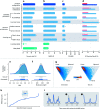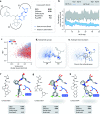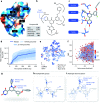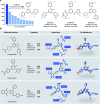Structure-based de novo drug design using 3D deep generative models
- PMID: 34760151
- PMCID: PMC8549794
- DOI: 10.1039/d1sc04444c
Structure-based de novo drug design using 3D deep generative models
Abstract
Deep generative models are attracting much attention in the field of de novo molecule design. Compared to traditional methods, deep generative models can be trained in a fully data-driven way with little requirement for expert knowledge. Although many models have been developed to generate 1D and 2D molecular structures, 3D molecule generation is less explored, and the direct design of drug-like molecules inside target binding sites remains challenging. In this work, we introduce DeepLigBuilder, a novel deep learning-based method for de novo drug design that generates 3D molecular structures in the binding sites of target proteins. We first developed Ligand Neural Network (L-Net), a novel graph generative model for the end-to-end design of chemically and conformationally valid 3D molecules with high drug-likeness. Then, we combined L-Net with Monte Carlo tree search to perform structure-based de novo drug design tasks. In the case study of inhibitor design for the main protease of SARS-CoV-2, DeepLigBuilder suggested a list of drug-like compounds with novel chemical structures, high predicted affinity, and similar binding features to those of known inhibitors. The current version of L-Net was trained on drug-like compounds from ChEMBL, which could be easily extended to other molecular datasets with desired properties based on users' demands and applied in functional molecule generation. Merging deep generative models with atomic-level interaction evaluation, DeepLigBuilder provides a state-of-the-art model for structure-based de novo drug design and lead optimization.
This journal is © The Royal Society of Chemistry.
Conflict of interest statement
There are no conflicts to declare.
Figures





Similar articles
-
Advances and Challenges in De Novo Drug Design Using Three-Dimensional Deep Generative Models.J Chem Inf Model. 2022 May 23;62(10):2269-2279. doi: 10.1021/acs.jcim.2c00042. Epub 2022 May 11. J Chem Inf Model. 2022. PMID: 35544331 Review.
-
De novo molecular design with deep molecular generative models for PPI inhibitors.Brief Bioinform. 2022 Jul 18;23(4):bbac285. doi: 10.1093/bib/bbac285. Brief Bioinform. 2022. PMID: 35830870
-
DNMG: Deep molecular generative model by fusion of 3D information for de novo drug design.Methods. 2023 Mar;211:10-22. doi: 10.1016/j.ymeth.2023.02.001. Epub 2023 Feb 9. Methods. 2023. PMID: 36764588
-
Multi-objective de novo drug design with conditional graph generative model.J Cheminform. 2018 Jul 24;10(1):33. doi: 10.1186/s13321-018-0287-6. J Cheminform. 2018. PMID: 30043127 Free PMC article.
-
De Novo Molecule Design Using Molecular Generative Models Constrained by Ligand-Protein Interactions.J Chem Inf Model. 2022 Jul 25;62(14):3291-3306. doi: 10.1021/acs.jcim.2c00177. Epub 2022 Jul 6. J Chem Inf Model. 2022. PMID: 35793555 Review.
Cited by
-
Open-Source Browser-Based Tools for Structure-Based Computer-Aided Drug Discovery.Molecules. 2022 Jul 20;27(14):4623. doi: 10.3390/molecules27144623. Molecules. 2022. PMID: 35889494 Free PMC article. Review.
-
Moldrug algorithm for an automated ligand binding site exploration by 3D aware molecular enumerations.J Cheminform. 2025 May 26;17(1):85. doi: 10.1186/s13321-025-01022-3. J Cheminform. 2025. PMID: 40420238 Free PMC article.
-
Interpretable Machine Learning Models for Molecular Design of Tyrosine Kinase Inhibitors Using Variational Autoencoders and Perturbation-Based Approach of Chemical Space Exploration.Int J Mol Sci. 2022 Sep 24;23(19):11262. doi: 10.3390/ijms231911262. Int J Mol Sci. 2022. PMID: 36232566 Free PMC article.
-
Molecular Generative Model via Retrosynthetically Prepared Chemical Building Block Assembly.Adv Sci (Weinh). 2023 Mar;10(8):e2206674. doi: 10.1002/advs.202206674. Epub 2023 Jan 3. Adv Sci (Weinh). 2023. PMID: 36596675 Free PMC article.
-
Applications of machine learning in computer-aided drug discovery.QRB Discov. 2022 Sep 1;3:e14. doi: 10.1017/qrd.2022.12. eCollection 2022. QRB Discov. 2022. PMID: 37529294 Free PMC article. Review.
References
LinkOut - more resources
Full Text Sources
Other Literature Sources
Miscellaneous

